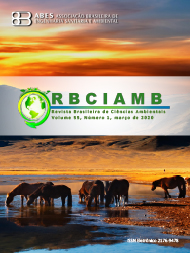INFLUENCE OF INORGANIC PHOSPHORUS AND PH VALUE ON THE REMOVAL OF AQUEOUS ENVIRONMENT GLYPHOSATE-BASED FORMULATION BY ADSORPTION
DOI:
https://doi.org/10.5327/Z2176-947820200557Keywords:
Herbicide. Nutrients Competitive adsorption.Abstract
Water resources degradation due to atrophic activities has depleted the
physical-chemical characteristics of surface waters, interfering in the mobility
of the compounds that are capable of settling on sediments. This work assessed
the effect of phosphorous concentration and pH value on kinetics and adsorption
capacity of glyphosate (commercial solution) in expanded clay, using a bench scale system composed by a batch-operated fixed-bed column reactor with internal recirculation of adsorbate. An experimental planning model was used for three phosphorous concentrations, 0.8, 8 and 16 mg.L-1 as well as three pH values of 4, 7 and 10, totaling 9 tests. It was verified that the increase in pH and phosphorous
concentration led to a decrease in adsorption velocity, while the kinetical
mechanism was affected just by phosphorous concentration, prevailing a pseudosecond
order mechanism for concentrations of 0.8 and 8 mg.L-1, and a intraparticle
mechanism for the highest concentration. The adsorption capacity was affected
by both parameters. For each increment of 0.16 in pH value and 0.22 mg.L-1 in
phosphorous concentration, the adsorbed mass of glyphosate decreased by
0.000385 and 0.000205 mg.g-1, respectively. Thus, it was concluded that the
increase in pH and phosphorous concentration decreased both the capacity
and speed of glyphosate adsorption (commercial formulation), while the kinetic
mechanism was only altered for phosphorous concentration of 16 mg.L-1.
Downloads
Downloads
Published
How to Cite
Issue
Section
License
Copyright (c) 2020 Revista Brasileira de Ciências Ambientais

This work is licensed under a Creative Commons Attribution 4.0 International License.


























